Project NE – Phase 1 – A Complete Waste to Energy FGT Plant from Economiser Outlet to Stack
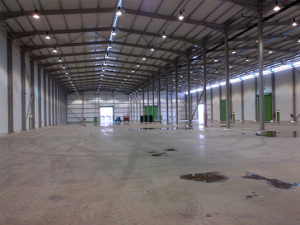
| Programme | |
| Engineering Order date: | February 2012 |
| Full Order date: | March 2012 |
| Installation commenced: | May 2012 |
| Substantial completion: | December 2012 (7 months) |
| Commissioning commenced: | January 2013 |
This project ordered in February 2012 involves all of the elements of a flue gas treatment plant and was installed as part of an innovative new build Advanced Thermal pyrolysis waste to energy plant in Avonmouth.
Broadly, the scope includes:
- Ducting – flanged and bolted, insulated, with instrumentation
- Bag filter – 140,000 Am3/hr with PTFE on glass bags, offline cleaning, online maintenance
- Integrated access – bag filter staircase and walkway
- Residue discharge – blow line to residue hopper discharging into FIBC
- ID main fan – 450kW EF1 fan unit
- HCl abatement – sodium bicarbonate silo with bifurcated hopper (twin outlet)
- Dioxin abatement – using PAC (Powdered Activated Carbon) via suction line
- Continuous Emissions Monitoring System (CEMS)
- Duty and standby plant compressors and compressed air lines throughout site
- Compressed air desiccant dryers
- Full and bespoke Allen Bradley/Rockwell control software design
- One main control panel, two satellite control panels
- Air control panels
- Waste Incineration Directive Compliant
- Integrates into clients main SCADA system
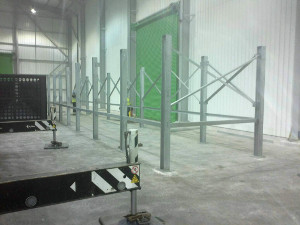
Installation
Filter Designs were the first to install any significant equipment on site. The filter body is supported on a galvanised support structure and was the first item to be installed. Stress calculations using Finite Element Analysis (FEA) are now achived within our 3D CAD drawings package. Computational Fluid Dynamics (CFD) is also undertaken as part of the design process, to ensure that the gas flow is evenly distributed throughout the filter as idealistically as possible.
Furthermore if required, our CAD package can now automate the entire filter system design, creating component parts and a complete list of assembly items – bolts lists, steel weights and so on.
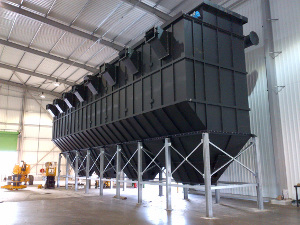
After the support is installed, the main filter bodies are lifted into position.
The filter inlet section has a gas inlet distribution section which encourages the down-flow of gas, allowing easy release of dust particulate from the filter bags.
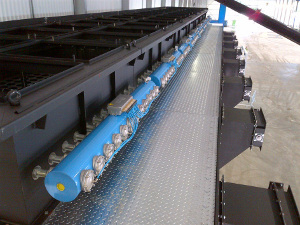
The filter here is actually four sections, each with two inlet and two outlet valves. This allows online cleaning and offline maintenance.
Online cleaning is useful if the characteristics of the dust create the possibility of re-entrainment.
Online maintenance allows one section (one quarter of the filter in this case) to be closed without adverse effects on the filtration velocity, therefore any long term maintenance requirements for the filter bags, filter cages or pulse control system can be undertaken without the need to shut down the main process.
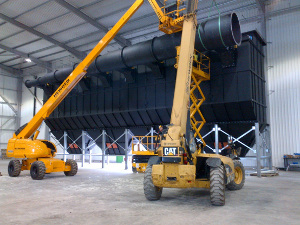
The filter ducting is profiled to maintain the correct dust carrying velocities along its length.
Each filter section has a hopper access door, a level probe to indicate high level of dust, a screw conveyor and a rotary valve.
The rotary valve discharges into a pneumatic lean phase blow line.
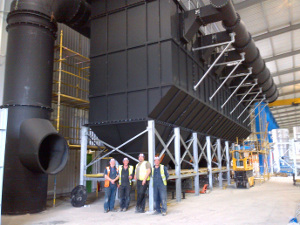
Prince William and Kate Middleton’s royal wedding date of April 29, 2011 was a bank holiday throughout the United Kingdom. Being terribly British, the erection team make their celebrations on site.
‘Time served’ erectors who are reliable, skill full, honest and hardworking are hard to come by. Our core team of erectors are subcontractors, but we have worked with them on numerous projects to good effect.
Filter Designs have invested in them by arranging Fork Lift Truck, Telehandler, MEWPS and other licenses required on our projects. Recent projects have been to Lancing (South Coast), Girvan (West Coast Scotland), Slough (London area), Oxfordshire, Oban (Scotland), Dreghorn (Scotland), Clydesmill (Scotland), Bedfordshire and further around the UK.
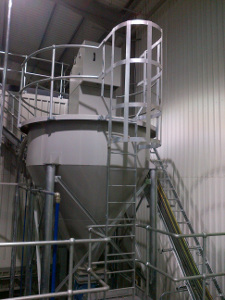
Any dust residue created by the waste to energy plant is filtered by the bag filter system and then conveyed via the pneumatic conveying line to a hopper.
This hopper vents via a smaller pulse jet cartridge filter, similar to the type used on the top of storage silos. The dust falls readily down into a bulk bag FIBC.
This bulk bag is on a frame which is on load cells, therefore the operators know when to empty the bag from an alarm raised in the control room.
Part of our quick assembly compressed air line can be seen here in blue. The electrical cabling is supported on cable trays as seen to the right.
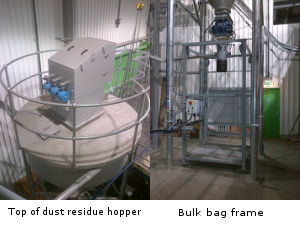
There is an inflating neck seal and sprung bulk bag hooks as part of the bulk bag support frame. The operator can press a local inflate switch which inflates the neck seal, providing a dust tight seal on the bulk bag. On removal, the neck seal is deflated.
As part of the control system, the status of the inflate/deflate switches are monitored so that the discharge rotary valve stops when an operator is changing over bags. Filter designs write an FDS for the plant control philosophy which is often tailored to suit client needs or programmer suggestions.

Filter Designs scope includes a complete Allen Bradley/Rockwell based control system.
To the left is a satellite panel which communicates via Ethernet to our main control panel which in turn communicates with the clients PLC as the master.
Several alarms are communicated outbound from our main panel and commands received from the clients master – such as controlled shutdown.
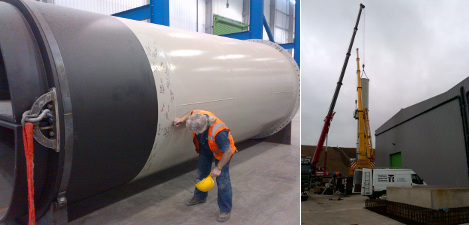
The chimney installation is relatively straight forward.
Filter Designs liaised with the clients engineers to coordinate dispersion modelling and obtaining the correct efflux velocities.
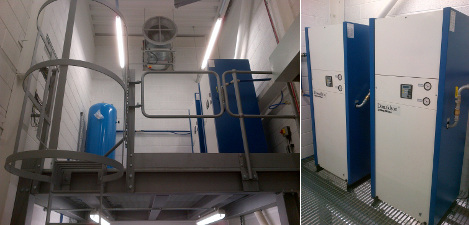
As part of the package, we designed a complete plant compressed air system. The CEMS equipment requires dried air as do many site instruments. The client also wished for a duty and standby system. Compressors are below this mezzanine, the twin dessicant driers are on it, with a reservoir and pressure sensor to the main system. Each compressor has a general alarm to the main control panel. The condensate drain goes to a pre-conditioning unit to remove any contaminants before going to a common drain.
As part of the project management meetings, it was suggested to client to provide a room with external air forced in at low level and air extraction out at high level. This keeps the room dust free and provides the compressors with the best possible conditions to operate reliably.
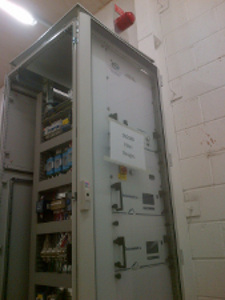
The Environment Agency insists on a continuous emissions monitoring system. The system we specify is a well proven gas analysis package, used extensively throughout the UK. The resulting emissions levels are sent to a standard windows computer and are trended. The calculated results from the emissions are used by the EA to determine site performance.
As part of the phase 2 system, a common standby CEMS system will be installed, giving the client ultimate resilience against any downtime.
Once again, a purpose built room is provided for this equipment which is protected from the likely conditions in the main plant.
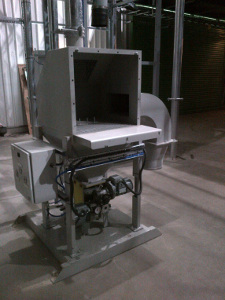
To combat the dioxins, furans and heavy metals which could be produced in the gas stream, PAC (Powdered Activated Carbon) is introduced. This reacts with the components in the gas stream and is introduced on a suction line to the inlet ducting before the bag filter.
Filter Designs can offer PAC injection with silo storage of PAC, via bulk bags and a lifting frame or in this case by 25kg bags in a small hopper arrangement.
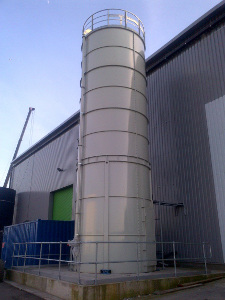
Outside the building, a silo holds sodium bicarbonate which is replenished via a tanker.
There are various alarm and mechanical protection systems in place to avoid over pressurisation during tanker filling.
The main control system knows when the driver is attempting to fill since he will need to lift the handle over the unicone coupled fill pipe.
The control system runs through several pre-checks before opening the fill line butterfly valve allowing the tanker to fill.
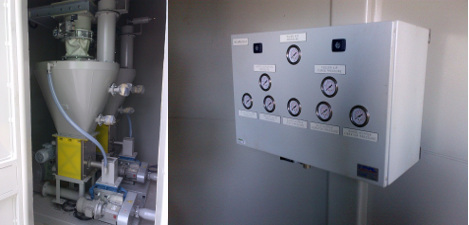
The silo has a twin outlet – one for stream one and one for stream two.
Each system drops sodium bicarbonate into a ‘surge hopper’ which then meters the reagent out according to the HCl level within the outgoing gases based on the CEMS level.
A pneumatic conveying line transports the product in lean phase to the inlet ducts before the bag filter.
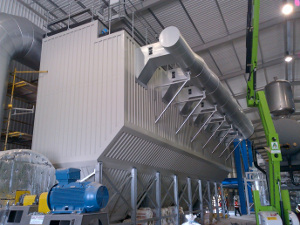
The filter system after being insulated and clad. This helps to maintain the temperature within the bag house thereby avoiding the possibility of condensation.
The 450kW inverter driven main fan is part insulated here. The inverter is installed in an enclosure and this is positively pressurised with filtered air from outside, thereby keeping the inverter cool and keeping dust out.
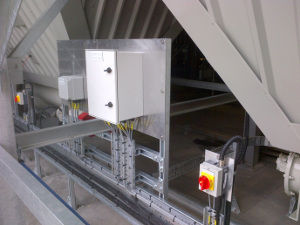
The electrics are one of the later items installed so that the installer can gain best access to all finished areas of the newly installed plant. Local isolators are mandatory, point to point tests are undertaken and the system warm commissioning can begin.
Plant commissioning items include:
- Oil level checks
- Fluorescent dye penetrant tests
- Fan vibration tests
- CEMS qualification
- Rotation checks
- Fan performance
- Level probe and instrument proving
- Programming commissioning and checks
As of May 2013, the site is producing power. Phase 2 is 70% complete.
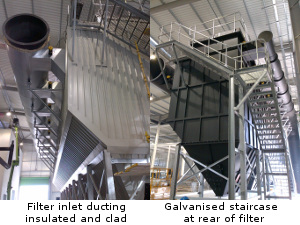
Documentation on this project included: Functional Design Specification, Power consumption, Electrics List, Process and Instrument Drawings, Operations and Maintenance Manual, over 200 fabrication CAD drawings, 3D CAD drawings, Finite Element Analysis and Computation Fluid Dynamics Results.
Filter Designs are ISO9001 compliant. We have installations worldwide to include China, Vietnam, Finland, Florida, England, Ireland, Scotland and Wales, Iran, Singapore, India and more.
Our recent Projects
We were contracted to provide 2 small Ceramic filters suitable for a small volume but with a design maximum temperature of 600°C. In addition the filters will be handling a syngas which cannot be mixed with oxygen so an alternative to compressed air would need to be used for the ‘Cleanpulse’ cleaning of the 25 Ceramic element in each of these CPC78 filters. In addition dosing of small amounts of a re-agent is required so the client also opted for a ‘Cleandose’ 25kg bag skid. Find out more about Project CAD below.


